
R.M.S. Ortona & the R.M.S.P. Arcadian 1899 to 1917
Please Note: Firefox and some other Search Engines may not be suitable
Use Google Chrome for this Web Page to load perfectly!
Please Note: All ssMaritime and other related maritime sites are 100% non-commercial and privately owned, thus ssmaritime is NOT associated with any shipping company or any other organisation! Although the author has worked and been involved in the passenger shipping industry for well over 60 years, but due to his old age and poor health, he was forced to retire. Yet, he has completed well over 1,550 Classic Liners, Passenger-Cargo Liners as well as humble converted C3 converted Migrant Liners, which has transported countless thousands of folk to the new world, as well on vacations’. Amazingly, ssmaritime.com has received 573.4 million visitors to date I trust the features online will continue to provide Classic Liner and Ship enthusiasts both the information they are seeking, but more so provide a great deal of pleasure and relive many happy memories!
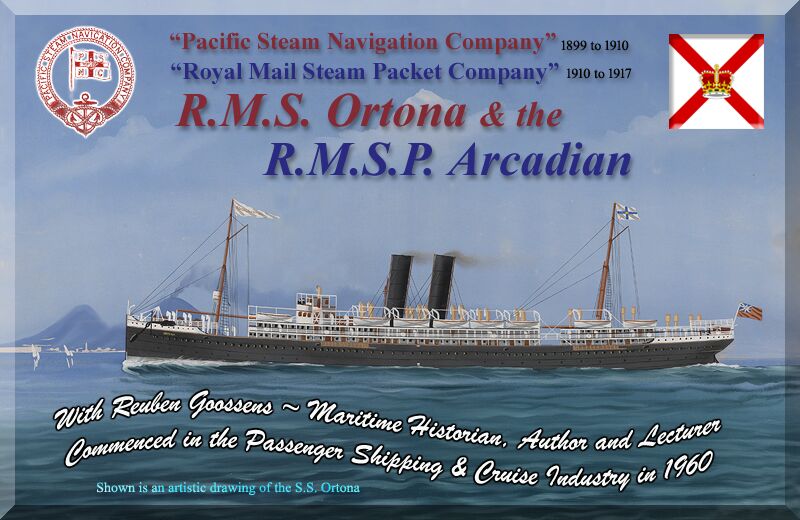
Sadly we do not
know who the artist is, but thank you Daniel Freiberg for sending
it; Daniel Morris (Yorkshire
Thus thank you kindly all my ssmaritime supporters for sending me your wonderful
photographs & images, for I could not have completed this feature without your help!
I am sorry but some of the images may not be of the highest quality, but they are the best that were available.
Page One contains her full history in both her guises, as the R.M.S. Ortona and the R.M.S.P. Arcadian, complete with her external and interior photographs as well as her complete ‘Specifications and Details’.
Whilst Page Two contains Deck Plans Souvenirs and other items of interest! But most importantly it has the remarkable true story as told by Medical Military Officer ‘Lieutenant Colonel, George Bray’ (1864 - 1933) R.A.M.C, (Royal Army Medical Corp), who was in charge of the Egyptian Corp’s at that time, and he was one of the survivors when the Troopship H.M.T Arcadian was torpedoed and sank so fast with so many lives lost, and he survived to tell the tale. His story is an amazing account of the events that took place on that terrible day! The Link to Page Two is at the bottom of this Page.
*********************
Who is the “Pacific
Steam Navigation Company” (PSNCo)? This company was formed
by an American named ‘William Wheelwright’ to operate
steamship services along the Pacific coast of
PSNCo services
commenced in 1840 with two wooden paddle steamers to
In 1870, the PSNCo
decided to extend services to
The PSNCo was
the largest steamship company in the world in 1873, but their
success was short-lived. Due to a combination of circumstances,
including political unrest, and competition from other shipping
lines (White Star amongst them), PSNCo found themselves in
financial difficulties and many ships were laid up, service
speeds were reduced, and departures became fortnightly again. Two
ships were sold to ‘Royal Mail Lines’, and four
others were chartered (and later sold) to the ‘Orient
Line’ for a new steamship service from London to
Australia via the Suez Canal. Conditions in the PSNCo original
trade area continued to deteriorate, and
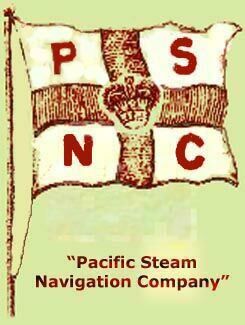
The passenger
liner “Ortona” was ordered to be constructed
by ‘Vickers, Sons & Maxim Ltd’ at
She was launched on July 19, 1899 and she was officially given the name “Ortona”, which is also the name of an Italian deep water port in the Adriatic sea (opposite Split in Croatia), not far from where she would eventually be sunk in 1917 by a German torpedo in the Mediterranean. When she entered the water, as always tugs took her in tow to the builder’s fit-out berth where she would be completed.
On October 26,
1899 the fine looking R.M.S. Ortona was officially registered
at
R.M.S. Ortona
departed Tilbury (
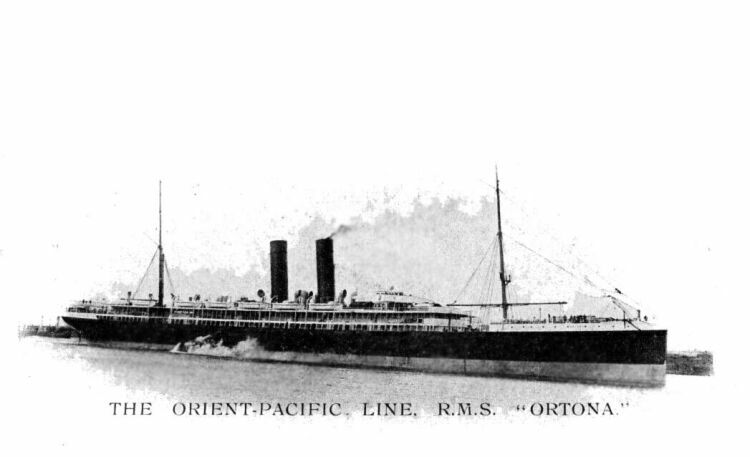
A very early postcard of the “Ortona”
The “Ortona
accommodated 140 First Class, 180 Second Class and 300 Third
Class passengers, being a total of 620 passengers.
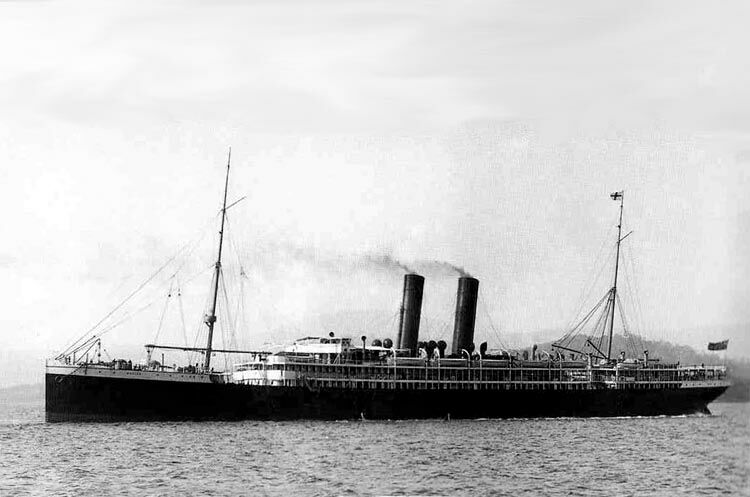
The R.M.S. Ortona
is seen during her maiden voyage to
Her schedule was
as follows;
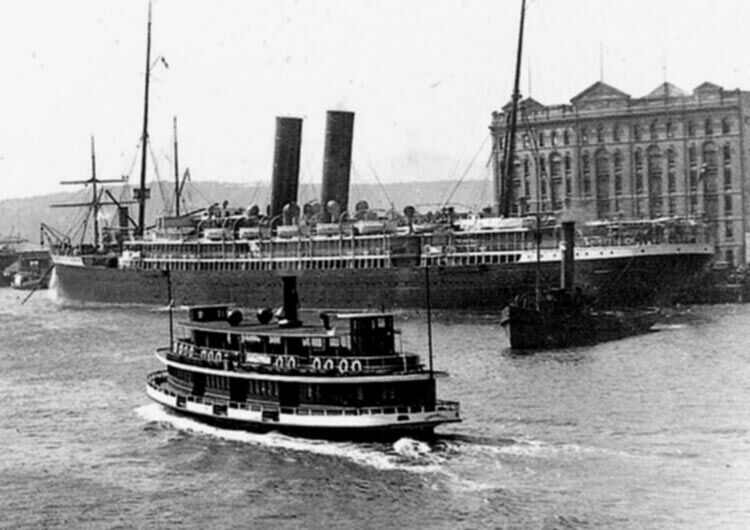
The
pulls away from her
Sydney Cove wharf being bound for
She sailed on
her route to
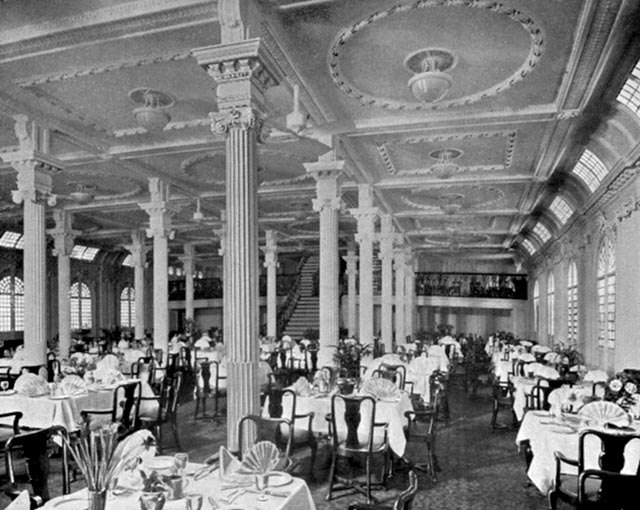
A magnificent
Dining Room indeed!
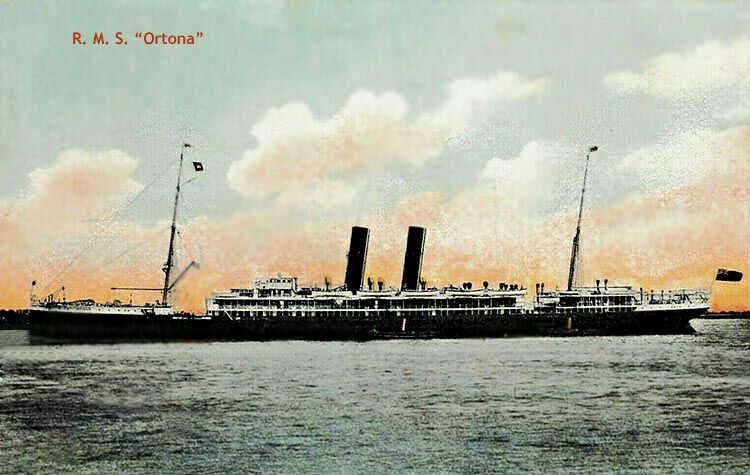
A fine colour
postcard of the R.M.S. Ortona, which could be purchased from the
ships shop
From December
1902, the “Ortona” was used for 10 months as
a troop ship at the end of the Second Boer War. Then on
October 9, 1903 she returned to the

A painting of the R.M.S. Ortona
By an unknown artist
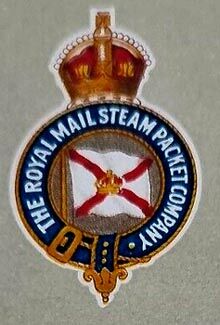
On May 8,
1906 the R.M.S. Ortona was purchased by the “Royal Mail
Steam Packet Company” (RMSPCo) together with the balance of
the PSNCo Australian fleet. For the time being, RMSPCo continued
to operate her as usual under the “Orient Mail Line”
management name. The R.M.S. Ortona was reregistered at
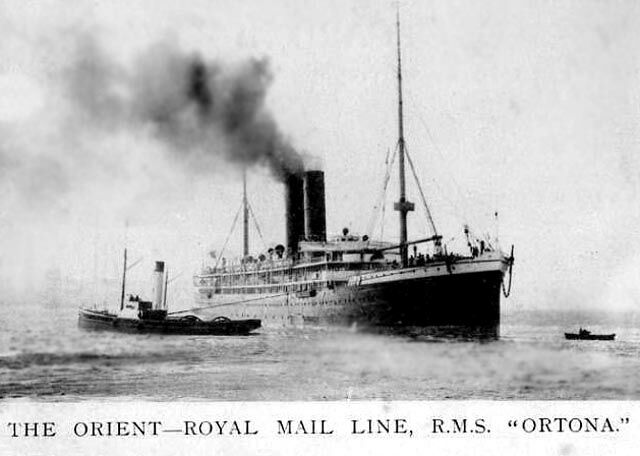
A postcard of the
R.M.S. Ortona remaining under the “Orient Royal Mail
Line” management until 1907
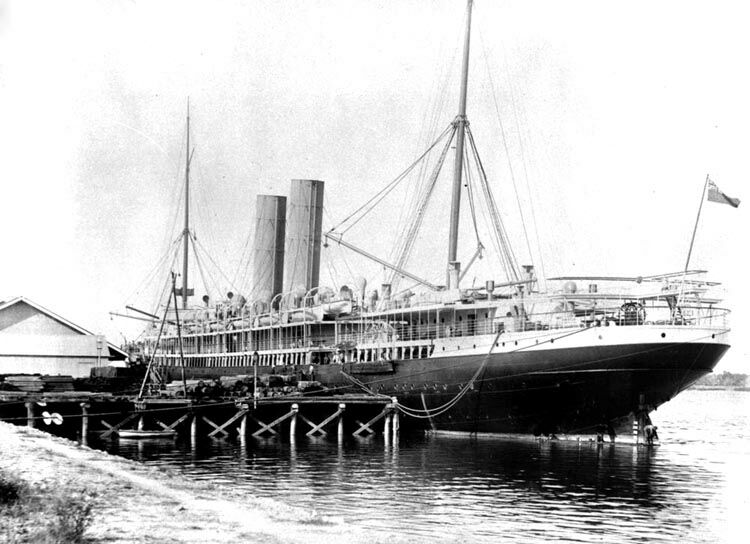
A fine stern
photograph of the R.M.S. Ortona seen berthed at the
on the
In
August-September 1907, the “All Gold’s”, or the
world famous
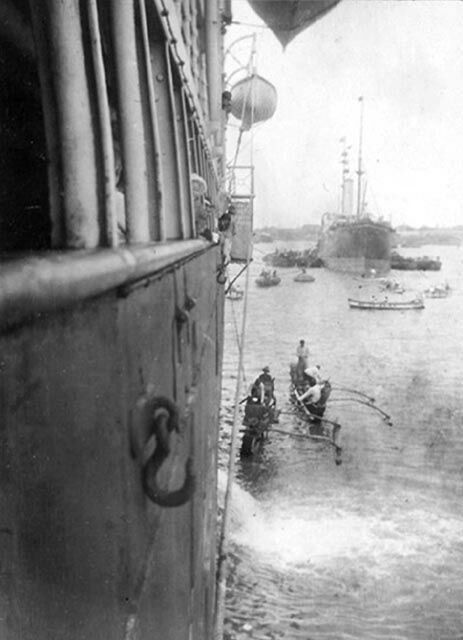
Above &
below: The “Ortona” is seen at
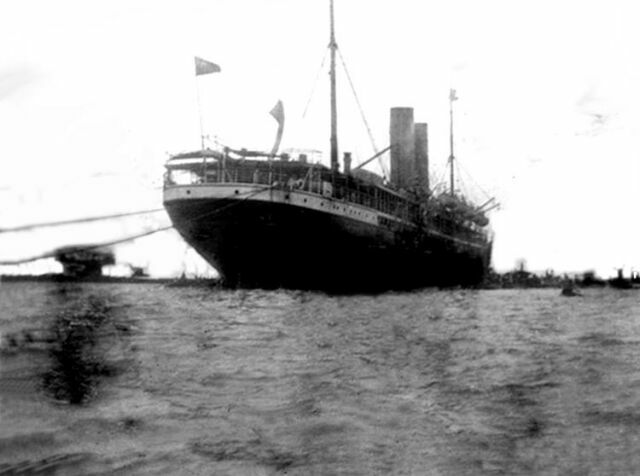
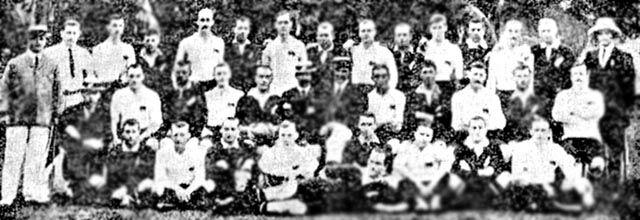
Above &
below: The ‘All Blacks’ Rugby League team are seen
at
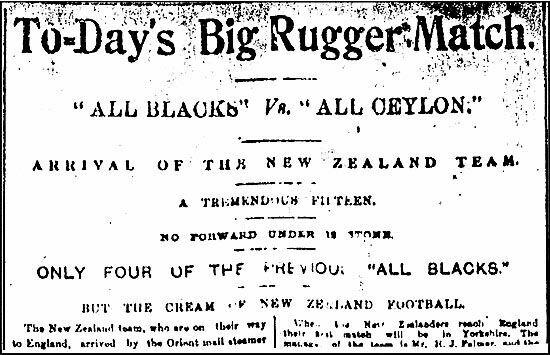
For interest,
the “All Blacks” won the match! The ship then continued
via
The R.M.S.
Ortona continued operating her regular Australian schedule until
her very last voyage to Australia, which she departed London (Tilbury)
Upon the return to the UK of the R.M.S. Ortona, ‘Royal Mail’ finally took over the management and operation of the “Ortona” and they now placed her on their West Indies services together with one of their smaller luxury cruise ships the 5,545 GRT, R.M.S.P. Tagus.
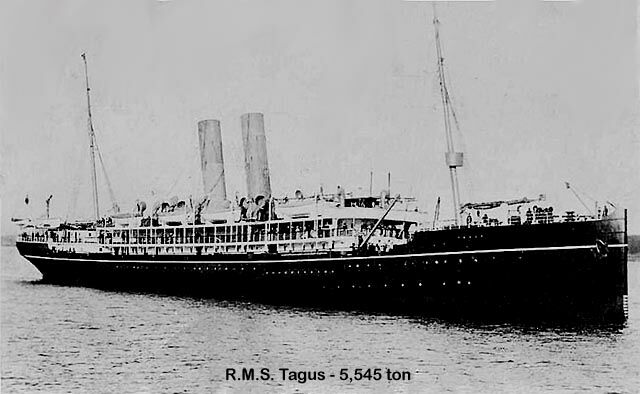
The 1899 built R.M.S.P. Tagus
From the day “Royal Mail” (RMSPCo) took delivery of the R.M.S. Ortona and they had plans for their acquisition and they now commenced to set this into motion. The truth is, they had huge plans for this very special ship, for she had many qualities not found on many other liners in those days, such as her excellent sailing capabilities, for she was such a well-built ship, for she was an exceptionally stable ship even in roughest of seas, also her machinery was the best of the time and without a doubt the most reliable! Thus “Royal Mail” commissioned their finest maritime architects and designers to work on her plans and recreate a whole new style of ship for she was to become the “Arcadian the Finest Yachting Cruiser in the world”!
In 1910, the
“Ortona” was sent to the “Harland &
Wolff’ shipyard in
She became rapidly a famous ship, for she was officially the world’s largest dedicated “Yachting Cruiser” at that time, and there was no doubt that the Media had proclaimed her as being “The most luxurious cruise ship to come on the market to date!”
*As all “Royal Mail” (RMSPCo) ships had names beginning with the letter “A”, was the reason why she was given a new name commencing with the letter “A”.
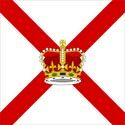
The “Royal
Mail” (RMSPCo) House Flag
*********************
Amazingly her decks were strangely marked, for they commenced from what is usually Boat Deck, which was officially “E Deck” and her deck went down to “A Deck”, with only another facility located aft of the engine room on what was termed as “Orlop Deck”. Thus there were a total of six passenger decks for a mere 320 guests.
As always I will commence topside far forward and slowly work aft and then go down deck by deck.
To read this deck, you would come either out of the forward Main Lobby onto the Promenade deck and walk aft just a little and there are stairs on either side that goes up to E Deck. Alternatively use the aft Lobby and use the nearest stairs there.
E (Boat) Deck was a long and a spacious deck and it was used for sports activities as well as for sunning and guest’s getting together for conversations. As the deck went far forward of the main superstructure guests could look back towards the Bridge one deck above, and the deck ended aft of the forward superstructure, as there used to be a hold between where there was a break the First and the Tourist Class section aft, but the ship was now all First class of course.
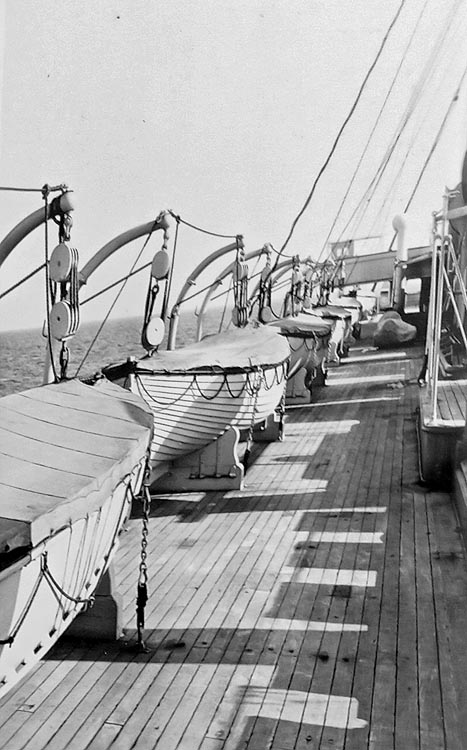
E (Boat) Deck portside looking forward to the Bridge wing
She was fitted with 12 lifeboats, 2 dinghies, 4 launches and 1 special motor boat.
Forward located above the two main Lounges below were Observation Decks and stairs would take you up above as these rooms were rather high with flat sides.
Far forward on this deck was the very spacious Social Hall that featured windows on three sides, port, forward and starboard sides. The venue featured wall and ceilings that were panelled in an Ivory cladding, but the lower walls and columns with touches of highly polished dark ebony, which was so beautiful! But what made this venue really stand out was the spectacular central stained glass dome!
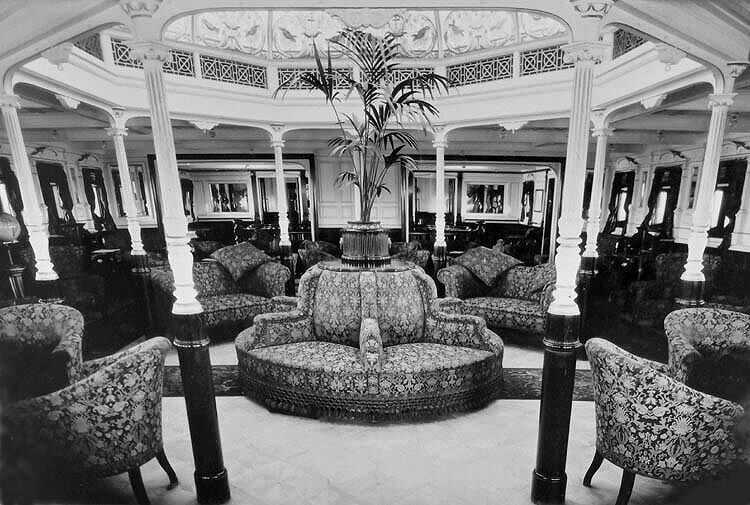
Above &
below: The Grandiose Social Hall and its superb stained glass
dome above
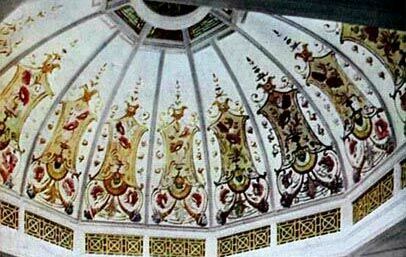
Although the carpeting was in a light shade, but the furnishings were as we can see of the very highest quality and comfort! The brocade was colourful and had touches of red, yellow, green and blue and a darkish background and it was elegantly created just for this ship. The central round sofa was especially created to be topped by a palm tree. There was a band stand located forward for the ships String Band with a Grand Piano (out of sight) forward slight of centre to starboard side. Aft the glass doors took you into the forward Foyer.
In the Foyer was the beautiful carved timber Main Stairwell which commences here on D Deck and goes all the way down to A Deck and the Restaurant.
On both sides of the Foyer were doors out to the Promenade deck.
This fine deck was a long and a wide external deck and would be well used during her luxury cruises. Ample seating would be placed all along the deck as well as tables, and her highly trained stewards would always be at hand to serve drinks, tea and coffee, and of course the traditional hot bouillon at 10.30 to 11.00 am.
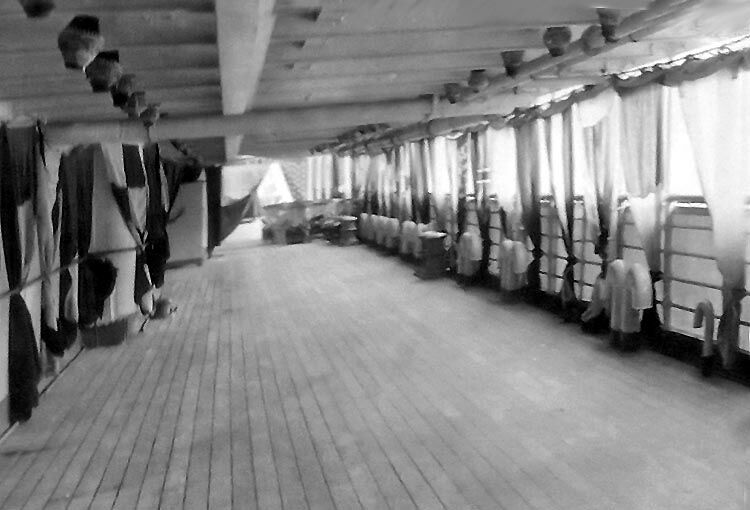
Promenade Deck - portside looking aft
On the Foyer’s aft bulkhead were two doors on each side being the entry into the Lounge. This venue was not exceptionally large, yet with it very high rounded ceiling it felt bigger than it actually was. This was a light shaded venue that was elegantly furnished with several writing tables, as well as timber tables and chairs all standing on a darker carpet.
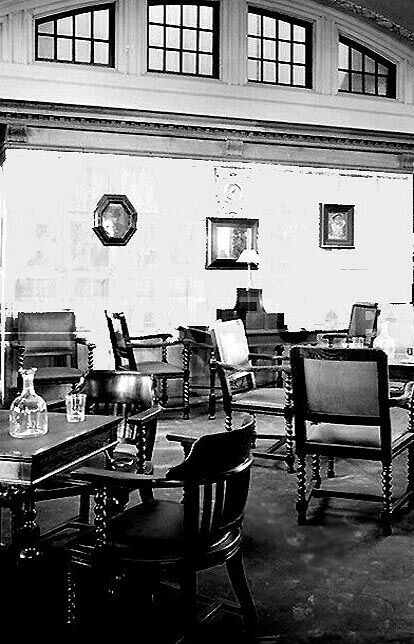
The Lounge
The aft bulkhead featured three paintings and high above there were a series of four curved windows facing aft of the ship.
To reach the next Public Venue, you would have to reach it via the Promenade Deck.
This is another elegant venue and it has the identical Dome as the one in the Social Hall, and also in the Library for that matter. This dome was a feature on this fine ship!
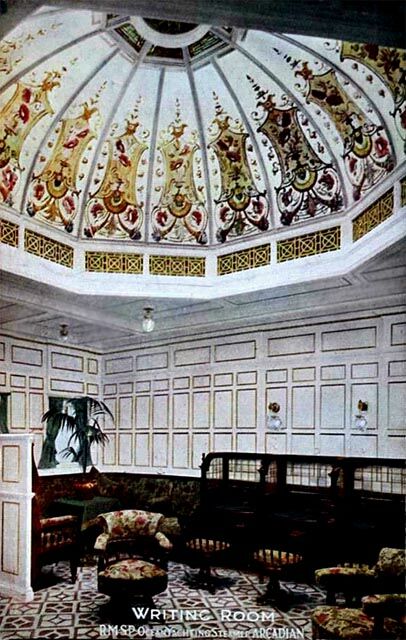
The luxurious Writing Room
The other Public
Venues further aft, one would either take a walk along the
Promenade Deck, or reach them via the aft Stair Well.
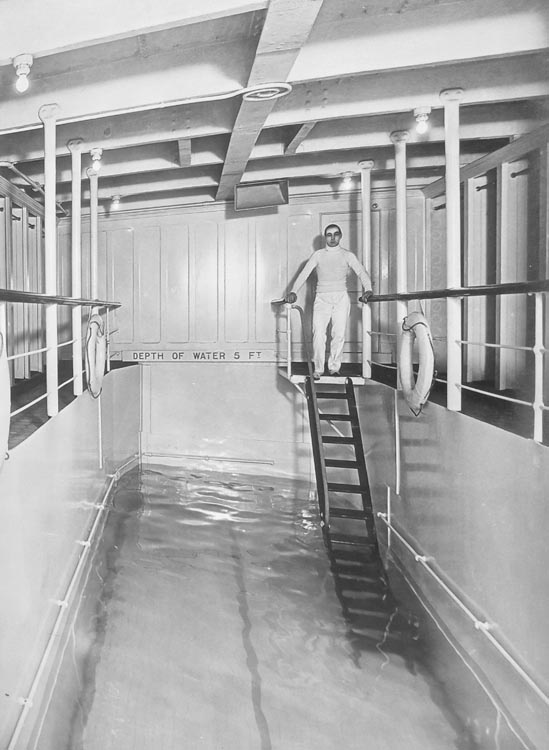
As you can see it was designed to be a two lane pool
This is the
first of the decks that contain accommodations, and it is
interesting to note that the Arcadian had no upper berths
whatsoever! Thus every bed was just that a bed and not a bunk,
for cruising on the “Arcadian” was sailing in sheer
luxury, thus this was not sailing on some sort of migrant ship
pretending to be a cruise ship, like all the others at sea in
those days. This ship was designed 100% as a luxury vacation
resort at sea!
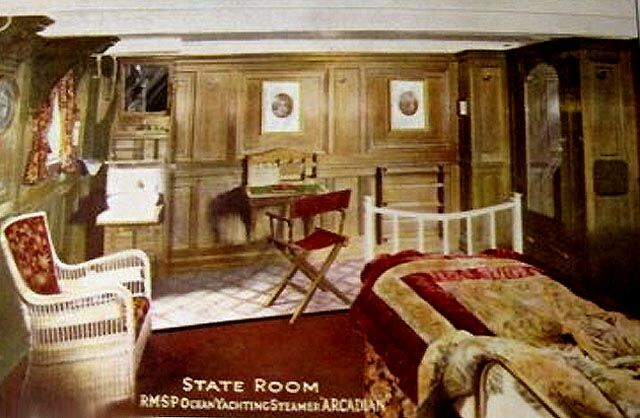
A typical single bed cabin
Cabins on board were either a single, twin bed or a three bed cabin most rooms did have to use share facilities, but these were of exceptionally high standard and kept to the highest possible standard with staff on hand 24 hours per day.
Further aft was the Pursers Office, a Tours Office as well as a Ships Shop, with the ships Doctor’s waiting room and office and the ships hospital a little further aft of these, etc.
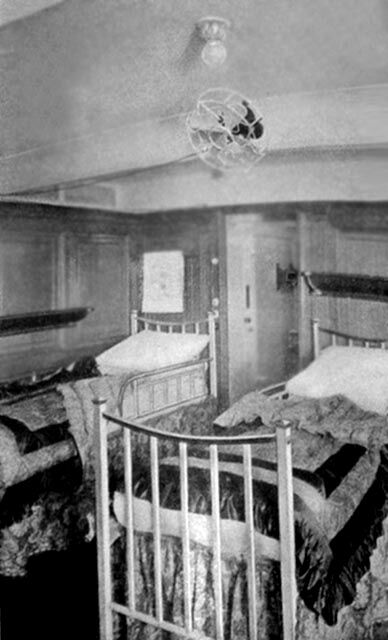
A partial view of a twin bedded cabin
The forward Main Stairwell will have you arrive on B Deck where there were two very spacious multi-room super luxury Suites located amidships on the starboard side and both had spacious bed room and a very large Lounge, and full private bathrooms with a full sized bath with a shower, WC, and a Bidet, and hot and cold wash basin etc. I just wish there were images available of these magnificent suites, but I have been unable to locate any, sorry for that.
Forward of the Main Stairway was the Grand Dining Room’s upstairs aft Balcony hanging high above the huge spectacular Dining Room below, which was unchanged from the day the ship had been built, for it was a piece of art to behold! But a grand stairs did come down from this balcony into the Restaurant.
There was also a forward restaurant Balcony on B Deck being a large Band Stand where the String Band would play softly during dinner. Forward on B Deck were some more cabins with their own stairwell.
Located at the aft Lobby was the Beauty Salon and the Men’s Hair Dresser, and yet another shop and of course further cabins.
From the Main Stairwell you would arrive in a grand style, walking down a huge stairway into the Dining Room, thus ladies would come to dinner wearing their finest gowns and jewellery and their finest fur stoles, and French perfumes. Men would wear their dinner suits and a white scarf for this Venue demanded absolute Elegance! The Dining Room was elegance supreme and the company decided that it would not be changed from when it was originally constructed as it was simply perfection!

The Grand Restaurant
The venue featured three rows of six round fluted highly decorative floor to ceiling marble columns that made a huge impression to this huge impressive venue. Along the sides she had all those large rounded windows with even smaller curved windows at the top, giving an impression if this was a venue placed on top of the ship, but no it was located on a lower deck of the ship. All this was a clever illusion for these windows were simply backlit and gave the impression it was exterior light, but it was not.
Furnishings were finished in fine dark timbers and seating was at tables for two or three, four, five, six and eight. The balcony only had tables of six.
There were cabins located forward of the Dining Room via a separate stairwell there were 10 twin bedded rooms, all having a porthole. Whilst far aft there were 18 cabins with a porthole for single bed, twin bedded or three bed cabins, but also 12 inside cabins all being single bed cabins.
This ends the tour of the ship, and I am so sorry that many images were simply not available, but I have done my very best to present this as much as possible of this very special ship to you!
*********************
The now 8,939 GRT, R.M.S. Arcadian was completed on September 23, 1911, and although she was officially prefixed as R.M.S., but “Royal Mail” (RMSPCo) decided to prefix her as the *R.M.S.P. Arcadian.
*R.M.S.P. of course stands for “Royal
Mail Steam Packet” (Company). For some reason they liked
promoting her like that, but occasionally we would see her as
“R.M.S.”
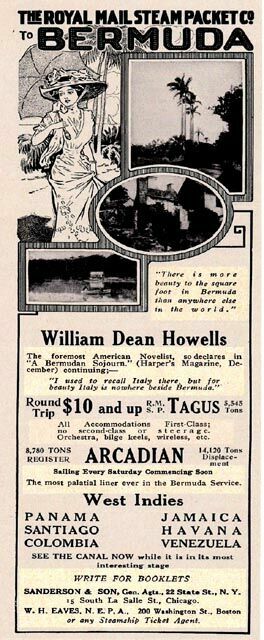
Note that under her name “Arcadian” it states “Sailing Every Saturday Commencing Soon”
And she did
operate a certain number of voyages to
R.M.S.P.
Arcadian Cruise 1 was due to depart in January 1912 and this
voyage she did depart from
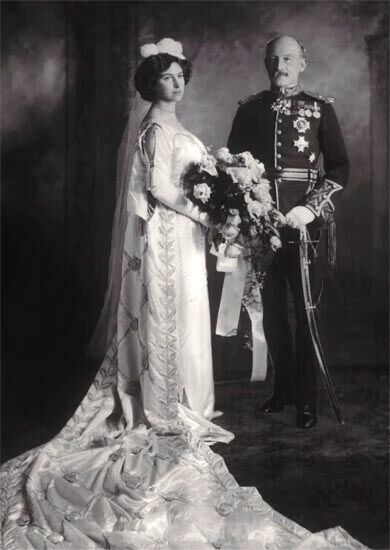
Lieutenant General
Sir Robert Baden-Powell & Olave St Claire Soames are seen
here on their wedding day
Cruise 1
concluded her Grand World Voyage in the
From the
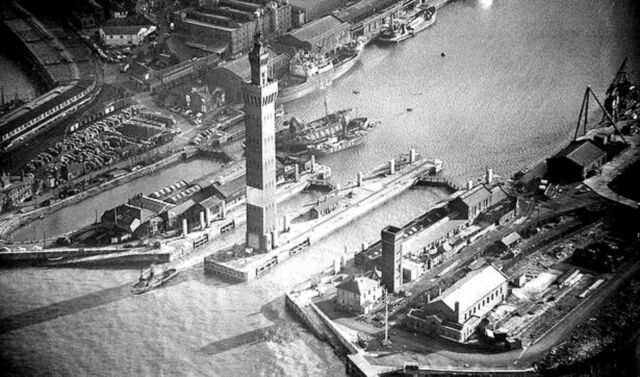
Prot Grimsby’s
tower was completed on March 27, 1852
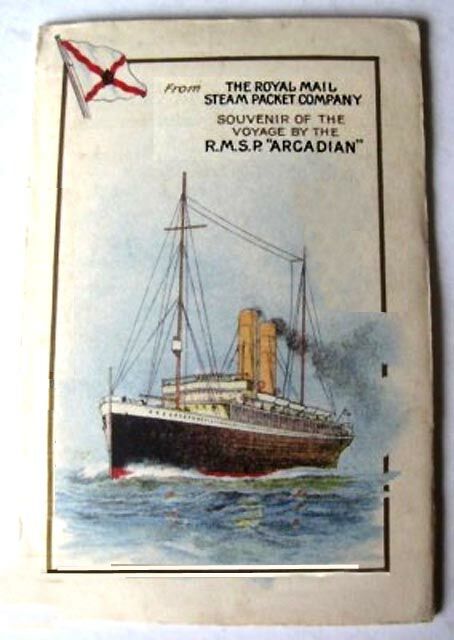
R.M.S.P. Arcadian’s Guest Cruise Guide
R.M.S.P.
Arcadian’s Cruise No. 2 was to ‘The Norwegian
Fjords’, departing from Grimsby on in June 18, 1913 was
under the command of Captain - Commander F.H.M. Custance, R.R.,
R.N.R., and his chief Officer being Lieut. B. Shillitoe, R.N.R.,
and below is an interesting photographic Passenger report of that
cruise. But first here is her schedule.
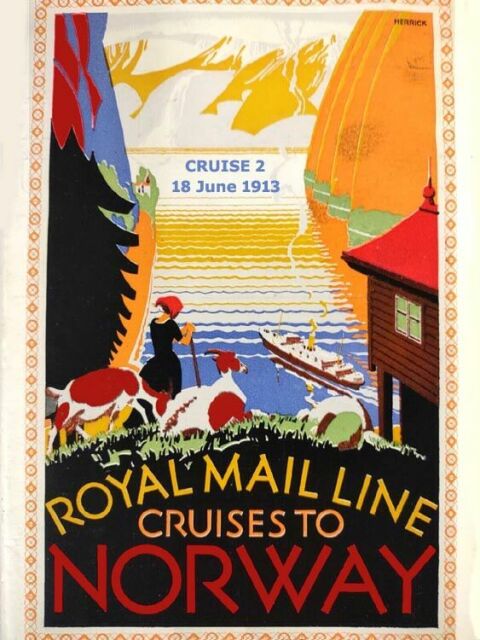
Above &
below: A brochure cover of Cruise 2, and the Itinerary below
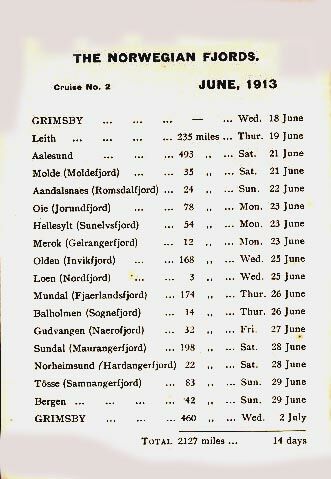
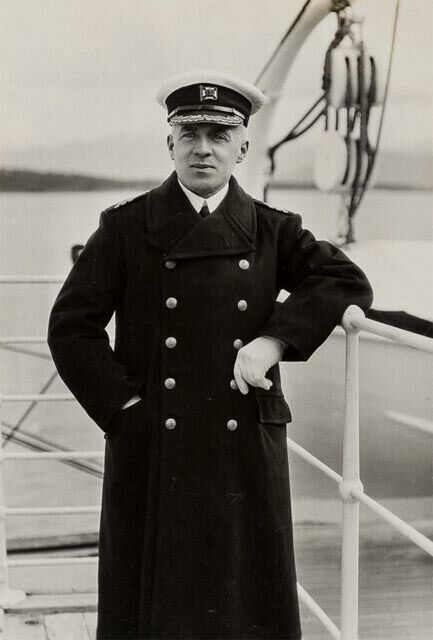
A photograph of
Captain - Commander F.H.M. Custance, R.R., R.N.R.
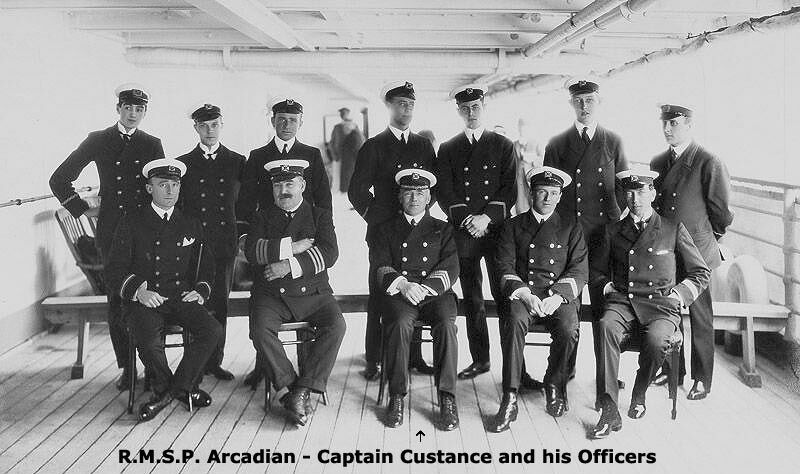
The Captain and His
Officers
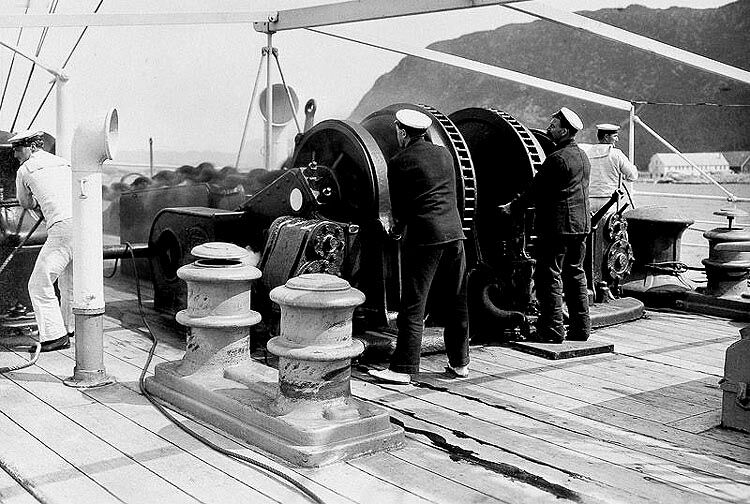
Drop anchor as it is time for Guests to explore the region
Located aft on Boat Deck lying across the ship, there is a very special sleek motor boat which is lowered by an electric crane into the water. In addition there are four more spacious motor boats located two on each side aft of boat deck.
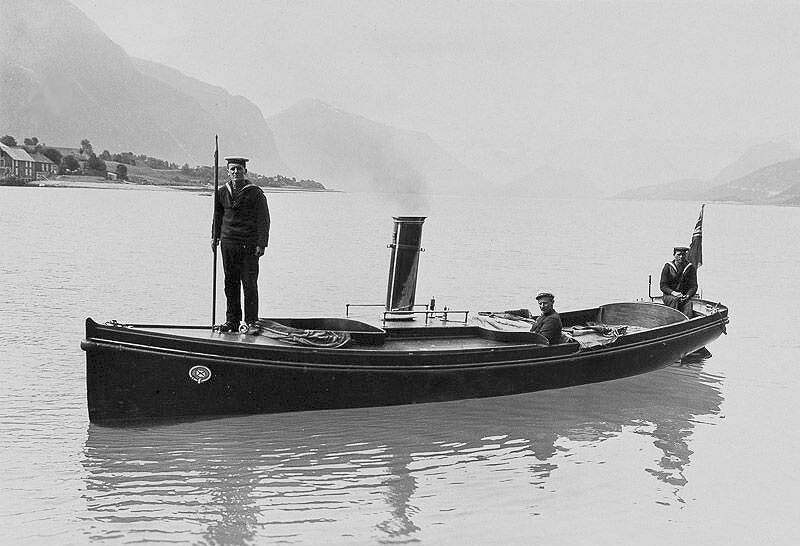
The ships special
motor boat
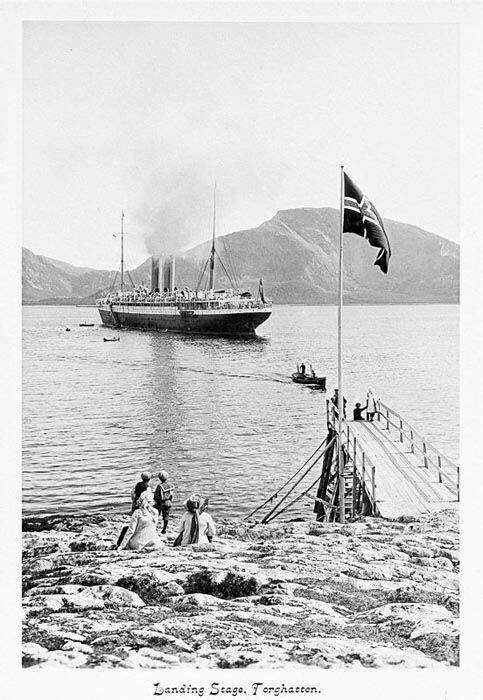
The “Arcadian
is seen at anchor at
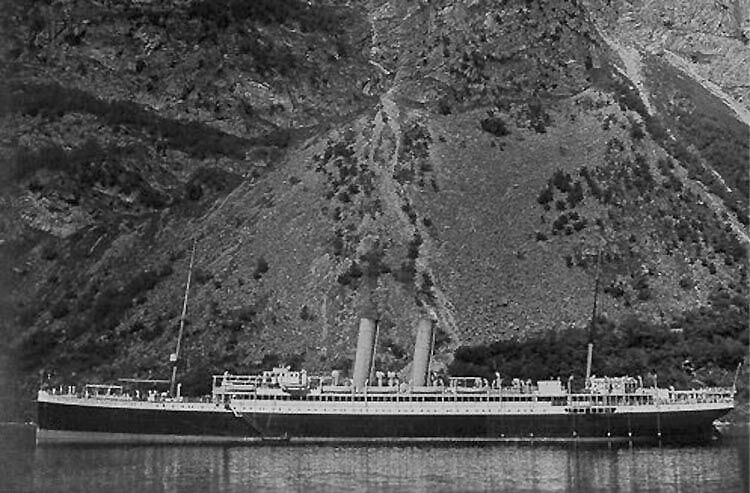
The
“Arcadian” is seen here at anchor at another Norwegian
bay
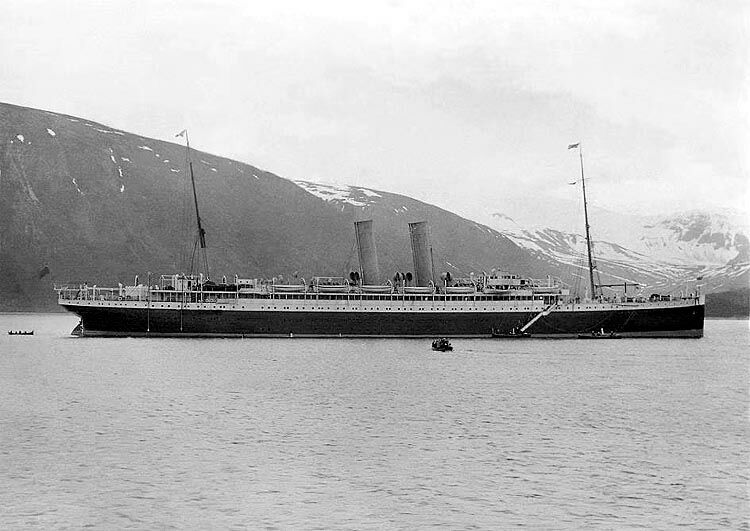
She has now reached
Tromso the
The
“Arcadian” continued to Cruise not only to Scandinavia,
but also the Mediterranean and the
*********************
On April 7, 1915
at
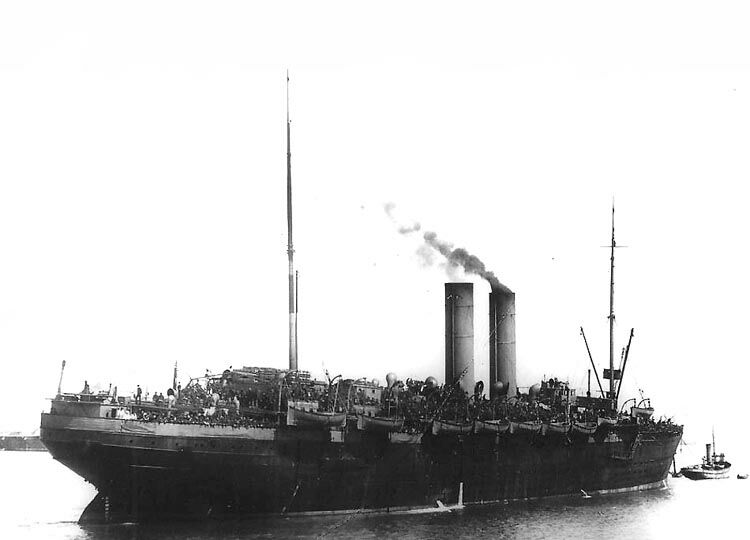
Troopship H.M.T. Arcadian
March 17 to 22,
1916 -
May 12 to 16,
1916 -
June 5 to 12,
1916 -
H.M.T. Arcadian set sail on April 15, 1917 with a company 1,335 troops and crew on aboard and she was being escorted by a Japanese Navy destroyer. It would be 26 miles north east of the Greek island of Milos in the Aegean Sea en-route from Salonika to Alexandria, that she became the target for the German submarine, the UC-74 being under the command of Kapitänleutnant Wilhelm Marschall who was slowly hunting down the “Arcadian”, and at this point her story was going to be cut terribly short.
Shortly after completing a boat drill at 1730 hours, and as one soldier stated:
“And we were dismissed just before a quarter to. About seven minutes afterwards a torpedo suddenly got us. Within 5 to 6 minutes of her being hit the “Arcadian” sunk, taking with her the lives of 277 of those who had been on board on this voyage, 10 out of 25 had been medical officers, including the eminent bacteriologist Sir Marc Armand Ruffer”. What amazed us all is that she sank within just five or six very short minutes, and before we knew it there was nothing left but a struggling mass of humanity and wreckage”.
A contemporary
newspaper article described how four
of “Arcadian’s” overcrowded lifeboats
were successfully lowered before she sank. Some of the dead were
cooks and stokers who were working below decks. The escorting
destroyer had two torpedoes launched at her while she was
attempting to rescue men from the water; survivors reported that
she had lowered three of her own boats while going “at full
speed”. More survivors, who had been clinging to a
raft, were rescued at midnight by the Q-ship HMS Redbreast.
“The
Mercury” (
SINKING OF THE ARCADIAN.
STORIES OF
SURVIVORS.
“Survivors of the troopship Arcadian,
which was torpedoed by the enemy in the Mediterranean last month
reached
A patrol boat did its best to help the swimmers. The submarine unsuccessfully fired two torpedoes at the patrol boat while it was engaged in rescue work. The men of the patrol boat performed a fine feat in launching here lifeboats while going at full speed.
The Arcadian had gone almost before it could be realised, there was no time for discipline. A large proportion of the engine room staff and of the cooks perished”.
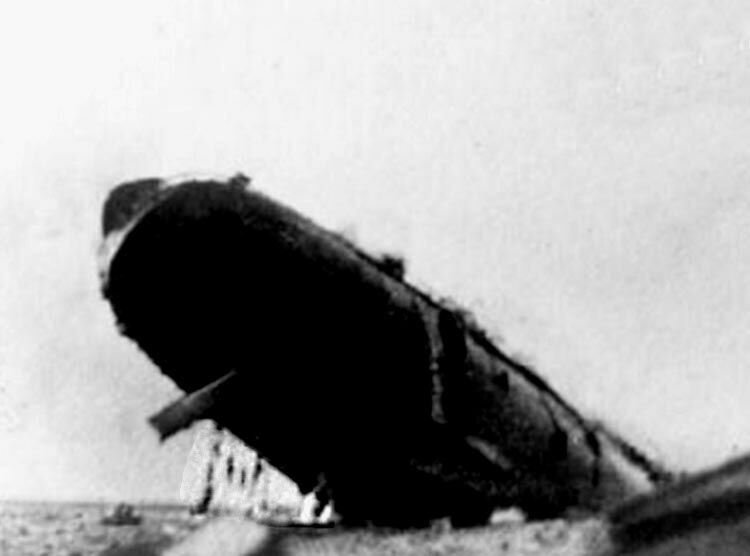
The “Arcadian” is seen sinking and men are seen climbing down ropes at her stern
On board the H.M.T. Arcadian at the time of the tragedy was Medical Military Officer ‘Lieutenant Colonel, George Bray’ (1864 - 1933) R.A.M.C, (Royal Army Medical Corp), who was in charge of the Egyptian Corp’s at that time, he would survive to tell the tale. His story is of his amazing survival, and his own account of events that took place on that terrible day, and it is located on Page Two. The Link is located at the bottom of this page.
PS: Kapitänleutnant
Wilhelm Marschall had sunk 120.460 GRT of ships, being 43
merchant ships operating as troop or in other capacities, or even
in a civilian roles, and 1 warship and killed countless lives. I
Wonder if he could sleep at night, being a Nazi, suppose he did,
they had no heart anyway, just like that scum (and it’s
leader who encouraged them) that invaded Capital Hill in
*********************
Names:
R.M.S. Ortona (1899-1910).
.
R.M.S. Arcadian (1910-1917).
Owners:
Pacific Steam Navigation Company (1899-1906).
.
Royal Mail Steam Packet Company (1906-17).
Management:
Orient Steam Navigation Company (1899-1907).
.
Royal Mail Steam Packet Company (1907-1917).
Service:
.
World War Two Duties (1915-1917).
Builder:
Vickers, Sons & Maxim Ltd,
Launched:
July 10, 1899.
Trials: October 27, 1899.
Delivered: October 29, 1899.
Maiden Voyage:
November 24, 1899.
Code Letters
Tonnage:
7,945 GRT - 4,115 NRT.
1912:
8,939 GRT.
Length:
500.6 ft - 152.55 m.
Beam:
55.3 ft - 16.84 m.
Draught:
33.7 ft - 10.24 m.
Propulsion:
Triple-expansion steam engine by Vickers.
Speed:
14 Knots service speed, 17.9 Knots maximum.
Accommodations:
1899:
Total 610 Passengers: 130 First Class, 180 Second Class, 300
Third Class passengers.
1912:
320 First Class passengers.
Passenger Decks:
6.
Fate:
Torpedoed April 15, 1917 by German submarine UC-74 near
*********************
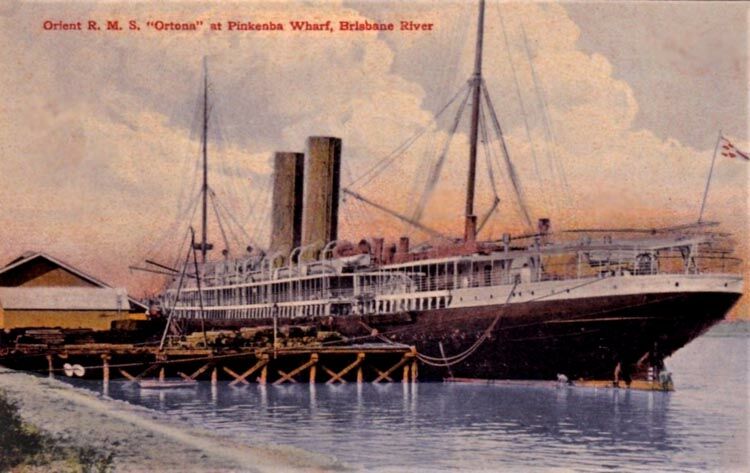
A fine stern
postcard of the R.M.S. Ortona seen berthed at the
on the
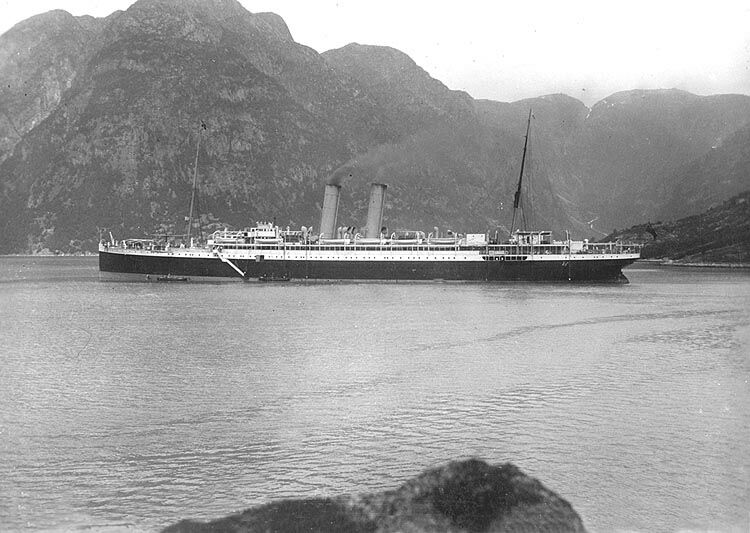
The R.M.S.P.
Arcadian is seen here during one of her Norwegian cruises
*********************
Visit - Page Two for Lieutenant Colonel, George Bray (1864
- 1933) R.A.M.C, (Royal Army Medical Corp)
Story of the German sub’s torpedo and the rapid sinking of the ship and his amazing full story!
Also her Deck Plans, Souvenirs and other items of interest!
“Blue Water Liners sailing to the
distant shores.
I watched them come, I watched them go and I watched them die.”
Featuring over 1,550 Classic Passenger Liners, Passenger-Cargo Liners & Classic Cruise Ships!
Or ENTER HERE
For interest: Sadly an email service to ssMaritime is no longer available, due to the author’s old age and chronic illness as well as being disabled, etc. In the past ssMaritime received well over 120 emails per day, but Mr. Goossens can no longer handle same. He sincerely regrets this!
*********************
ssMaritime.com & ssMaritime.net
Where the ships of the past make history & the 1914 built M.S. Doulos Story.
The Author has been in Passenger Shipping & the Cruise Industry for well over 60 years
In addition he was the founder of “Save the Classic Liners Campaign” in 1990.
Please Note: ssmaritime and associated sites are 100% non-commercial and the author seeks no funding or favours of any shape or form, never have and never will!
Photographs on ssmaritime and associate pages are by; the author or from the author’s private collection. In addition there are some images that have been provided by Shipping Companies and private photographers or collectors. Credit is given to all contributors. However, there are some photographs provided to me without details regarding the photographer/owner concerned.
This notice covers all pages; although, and I have done my best to ensure that all photographs are duly credited and that this notice is displaced on each page, that is, when a page is updated!
ssMaritime is owned & © Copyright by Reuben Goossens - All Rights Reserved